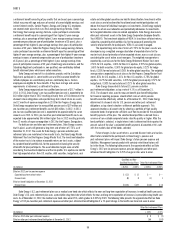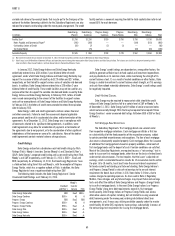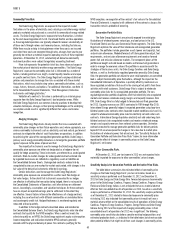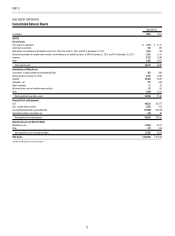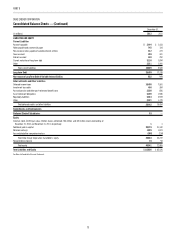Duke Energy 2012 Annual Report Download - page 84
Download and view the complete annual report
Please find page 84 of the 2012 Duke Energy annual report below. You can navigate through the pages in the report by either clicking on the pages listed below, or by using the keyword search tool below to find specific information within the annual report.
64
PART II
Summary of Sensitivity Analysis for Generation Portfolio and Derivative Price Risks
Generation Portfolio
Risks for 2013(a)
As of December 31,
Sensitivities for Derivatives
Beyond 2013(b)
As of December 31,
(in millions) 2012 2011 2012 2011
Potential effect on pre-tax net income assuming a 10% price change in:
Duke Energy
Forward wholesale power prices (per MWh) $34 $71 $103 $ 24
Forward coal prices (per ton) 11 2 ——
Gas prices (per MMBtu) 21 42 ——
Duke Energy Ohio
Forward wholesale power prices (per MWh) $32 $69 $103 $ 24
Forward coal prices (per ton) 11 2 ——
Gas prices (per MMBtu) 21 42 ——
(a) Amounts related to forward wholesale prices represent the potential impact of commodity price changes on forecasted economic generation which has not been contracted or hedged. Amounts related to forward coal prices
and forward gas prices represent the potential impact of commodity price changes on fuel needed to achieve such economic generation. Amounts exclude the impact of mark-to-market changes on undesignated contracts
relating to periods in excess of one year from the respective date.
(b) Amounts represent sensitivities related to derivative contracts executed to manage generation portfolio risks for periods beyond 2013. Amounts exclude the potential impact of commodity price changes on forecasted
economic generation and fuel needed to achieve such forecasted generation.
Credit Risk
Credit risk represents the loss that the Duke Energy Registrants would
incur if a counterparty fails to perform under its contractual obligations. To
reduce credit exposure, the Duke Energy Registrants seek to enter into netting
agreements with counterparties that permit them to offset receivables and
payables with such counterparties. The Duke Energy Registrants attempt
to further reduce credit risk with certain counterparties by entering into
agreements that enable obtaining collateral or terminating or resetting the
terms of transactions after specifi ed time periods or upon the occurrence of
credit-related events. The Duke Energy Registrants may, at times, use credit
derivatives or other structures and techniques to provide for third-party credit
enhancement of their counterparties’ obligations. The Duke Energy Registrants
also obtain cash or letters of credit from customers to provide credit support
outside of collateral agreements, where appropriate, based on a fi nancial
analysis of the customer and the regulatory or contractual terms and conditions
applicable to each transaction. See Note 15 to the Consolidated Financial
Statements, “Risk Management, Derivative Instruments and Hedging Activities,”
for additional information regarding credit risk related to derivative instruments.
The Duke Energy Registrants’ industry has historically operated under
negotiated credit lines for physical delivery contracts. The Duke Energy
Registrants frequently use master collateral agreements to mitigate certain
credit exposures. The collateral agreements provide for a counterparty to
post cash or letters of credit to the exposed party for exposure in excess of an
established threshold. The threshold amount represents a negotiated unsecured
credit limit for each party to the agreement, determined in accordance with the
Duke Energy Registrants’ internal corporate credit practices and standards.
Collateral agreements generally also provide that the inability to post collateral
is suffi cient cause to terminate contracts and liquidate all positions.
The Duke Energy Registrants’ principal customers for its electric and gas
businesses are commodity clearinghouses, regional transmission organizations,
industrial, commercial and residential end-users, marketers, distribution
companies, municipalities, electric cooperatives and utilities located throughout
the U.S. and Latin America. The Duke Energy Registrants have concentrations of
receivables from such entities throughout these regions. These concentrations
of customers may affect the Duke Energy Registrants’ overall credit risk in that
risk factors can negatively impact the credit quality of the entire sector. Where
exposed to credit risk, the Duke Energy Registrants analyze the counterparties’
fi nancial condition prior to entering into an agreement, establish credit limits
and monitor the appropriateness of those limits on an ongoing basis.
Duke Energy Carolinas has a third-party insurance policy to cover certain
losses related to its asbestos-related injuries and damages above an aggregate
self insured retention of $476 million. Duke Energy Carolinas’ cumulative
payments began to exceed the self insurance retention on its insurance policy
during the second quarter of 2008. Future payments up to the policy limit
will be reimbursed by the third -party insurance carrier. The insurance policy
limit for potential future insurance recoveries for indemnifi cation and medical
cost claim payments is $935 million in excess of the self insured retention.
Insurance recoveries of $781 million and $813 million related to this policy are
classifi ed in the Consolidated Balance Sheets in Other within Investments and
Other Assets and Receivables as of December 31, 2012 and 2011, respectively.
Duke Energy Carolinas is not aware of any uncertainties regarding the legal
suffi ciency of insurance claims. Management believes the insurance recovery
asset is probable of recovery as the insurance carrier continues to have a strong
fi nancial strength rating.
The Duke Energy Registrants also have credit risk exposure through
issuance of performance guarantees, letters of credit and surety bonds on
behalf of less than wholly owned entities and third parties. Where the Duke
Energy Registrants have issued these guarantees, it is possible that they could
be required to perform under these guarantee obligations in the event the obligor
under the guarantee fails to perform. Where the Duke Energy Registrants have
issued guarantees related to assets or operations that have been disposed of
via sale, they attempt to secure indemnifi cation from the buyer against all future
performance obligations under the guarantees. See Note 7 to the Consolidated
Financial Statements, “Guarantees and Indemnifi cations,” for further
information on guarantees issued by the Duke Energy Registrants.
The Duke Energy Registrants are also subject to credit risk of their
vendors and suppliers in the form of performance risk on contracts including,
but not limited to, outsourcing arrangements, major construction projects and
commodity purchases. The Duke Energy Registrants’ credit exposure to such
vendors and suppliers may take the form of increased costs or project delays in
the event of non-performance.
Credit risk associated with the Duke Energy Registrants’ service to
residential, commercial and industrial customers is generally limited to
outstanding accounts receivable. The Duke Energy Registrants mitigate this
credit risk by requiring customers to provide a cash deposit or letter of credit
until a satisfactory payment history is established, subject to the rules and
regulations in effect in each retail jurisdiction, at which time the deposit is
typically refunded. Charge-offs for retail customers have historically been
insignifi cant to the operations of the Duke Energy Registrants and are typically
recovered through the retail rates. Management continually monitors customer
charge-offs and payment patterns to ensure the adequacy of bad debt reserves.
Duke Energy Ohio and Duke Energy Indiana sell certain of their accounts
receivable and related collections through CRC, a Duke Energy consolidated
variable interest entity. Losses on collection are fi rst absorbed by the equity
of CRC and next by the subordinated retained interests held by Duke Energy



